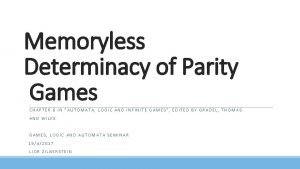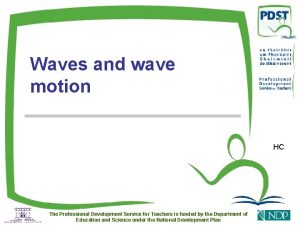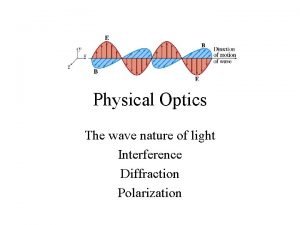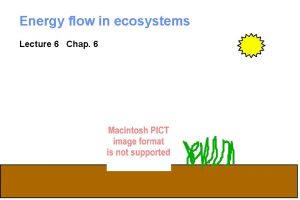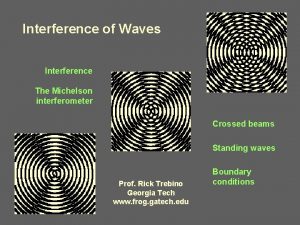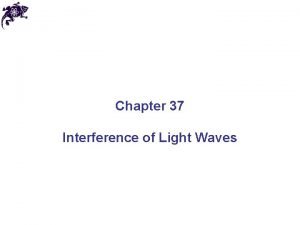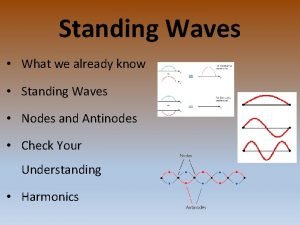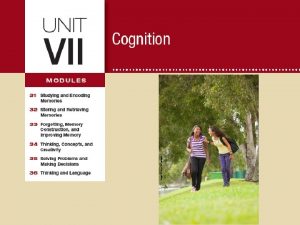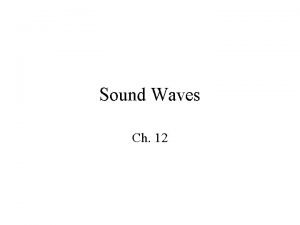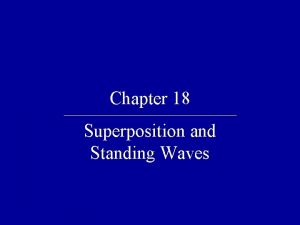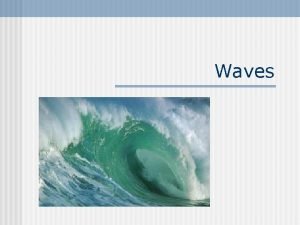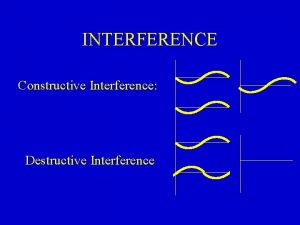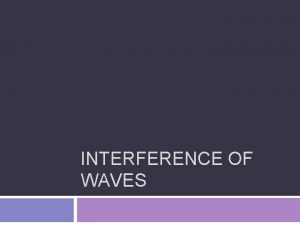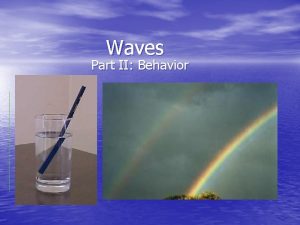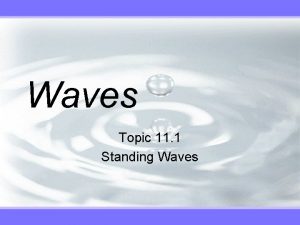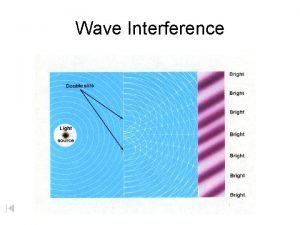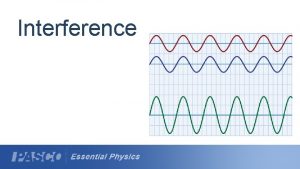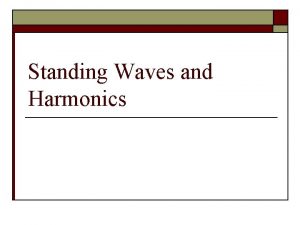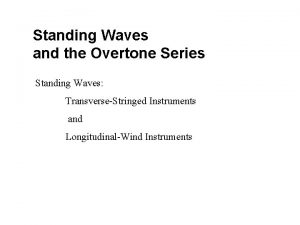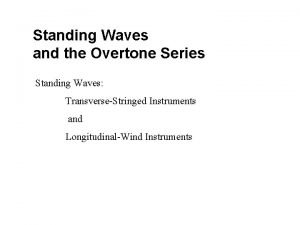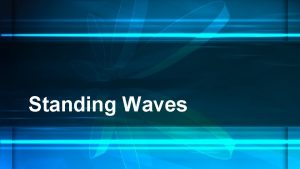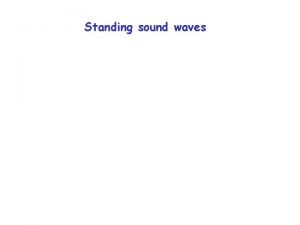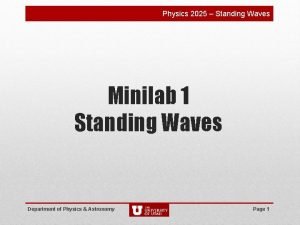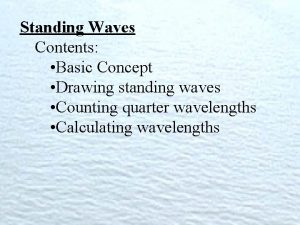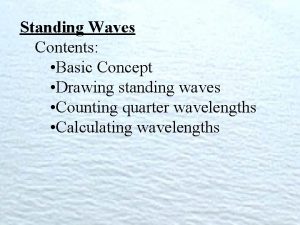Wave Interference and Standing Waves Interference Constructive interference



















- Slides: 19

Wave Interference and Standing Waves

Interference • Constructive interference – Peak and peak – Trough and trough + = • Destructive interference – Peak and trough + = Constructive Interference Example Destructive Interference Example

Superposition Principle • When two or more waves are in the same medium at the same time, they add together • The amplitude of the resulting wave is the sum of the amplitudes of the original waves • We think of crests as positive and troughs as negative, so adding a crest to a trough cancels out

Superposition Example • Two crests coming together (at 1 sec. intervals) • Solid lines show the result, dotted the originals

Standing Waves • When a traveling wave reflects back on itself, it creates traveling waves in both directions • The wave and its reflection interfere according to the superposition principle • With exactly the right frequency, the wave will appear to stand still – This is called a standing wave The wave reflects upon its self making a big patterned wave

Anti-node Max amplitude No motion • A node occurs where the two traveling waves have the same magnitude of displacement, but the displacements are in opposite directions (in other words, there is always destructive interference) – Net displacement is zero at that point – The distance between two nodes is ½λ • An antinode occurs where the standing wave vibrates at maximum amplitude (in other words, where there is always constructive interference)

• Wave on a string demo

Part 2

Standing Waves on a String ½λ Anti-node Max amplitude No motion • The ends of the string are fixed, so they must be nodes • We can determine the number of wavelengths based on the number of nodes and antinodes

Standing Waves on a String • The same string can produce multiple standing wave patterns at different frequencies. • We name these frequencies based on which standing wave pattern it produces: f 1 for the first, f 2 for the second, etc.

We can determine the wavelength of each standing wave based on the length of the string and the number of nodes and antinodes Two anti-nodes makes one complete wave thus f 2 the second harmonic λ = 2 m L = 2 m Three anti-nodes, 1 ½ waves Fundamental Frequency Thus f 3, the third harmonic Know as f 1 or the first harmonic λ = 1. 33 m Two nodes and one antinode is ½ λ λ = 4 m Note λ changes! L is constant. Use L = (n/2) λ to find λ (n is the number of the harmonic)

Standing Waves on a String – Frequencies • ƒ 1, ƒ 2, ƒ 3 form a harmonic series – ƒ 1 is the fundamental and also the first harmonic – ƒ 2 is the second harmonic • Since the standing wave pattern changes by (n/2)λ for every harmonic, the frequencies must double, triple. . . f 2 = 2 f 1 f 3 = 3 f 1 f 4 = 4 f 1

Standing Waves in Air Columns • We can also produce a standing sound wave in a column of air (like most wind instruments) • If one end of the air column is closed, a node must exist at this end since the movement of the air is restricted • If the end is open, the elements of the air have complete freedom of movement and an antinode exists

Tube Open at Both Ends We can find wavelengths and frequencies the same way we did for waves on a string; The only difference is nodes and antinodes are reversed

Standing Waves in Air Column Open at Both Ends • In a pipe open at both ends, the harmonics are equal to integral multiples of the fundamental frequency (first harmonic) fn = nf 1 where n = 1, 2, 3, … (the harmonic number)

Tube Closed at One End In a tube closed at one end, the closed end is a node and the open end is an antinode. This means we get different portions of a wavelength than for an open-open tube. The first harmonic is only ¼ of a wavelength. The next is ¾ of a wavelength, then 1 ¼ (or 5/4).

Standing Waves in an Air Column Closed at One End • The closed end must be a node • The open end is an antinode • There are no even multiples of the fundamental harmonic fn = nf 1 n = 1, 3, 5, … (the harmonic number)

Resonance and Forced Vibrations • When struck, an object will vibrate with a natural frequency (like a tuning fork) • If an outside force is applied at a frequency that matches the natural frequency of the system, the system is said to be in resonance • Resonance is when the natural frequency of the object is matched by the introduced frequency – – A swinging kid A buzzing car dash from loud bass Snare drums in band room Tacoma narrows bridge

Resonance in nature – Tacoma Narrows Bridge • When the wind pushed on the bridge at a frequency that matched the natural frequency of the bridge fell down! • bridge video online
 Constructive interference example
Constructive interference example Difference between constructive and destructive waves
Difference between constructive and destructive waves Constructive proof vs non constructive
Constructive proof vs non constructive Constructive proof vs non constructive
Constructive proof vs non constructive Constructive proof vs non constructive
Constructive proof vs non constructive Proof by contradiction examples
Proof by contradiction examples Apparent frequency formula
Apparent frequency formula Interference
Interference Difference between standing crop and standing state
Difference between standing crop and standing state Constructive vs destructive interference
Constructive vs destructive interference Constructive interference formula
Constructive interference formula Nodes and antinodes
Nodes and antinodes Compare and contrast p waves and s waves using venn diagram
Compare and contrast p waves and s waves using venn diagram Landform
Landform Standing wave nodes and antinodes
Standing wave nodes and antinodes What is proactive and retroactive interference
What is proactive and retroactive interference Retroactive interference
Retroactive interference Standing waves ch 12:1
Standing waves ch 12:1 Standing waves quiz
Standing waves quiz Standing waves
Standing waves



